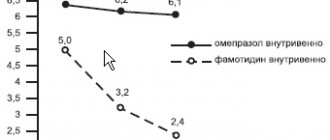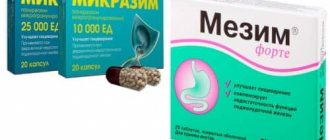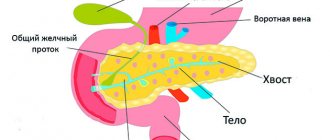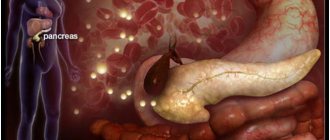Pharmacodynamics
This enzyme preparation, as Wikipedia indicates, is intended to improve digestive processes. The pancreatic enzymes included in its composition promote the breakdown of proteins, fats and carbohydrates, leading to complete absorption in the small intestine. The main substance pancreatin is also the INN of the drug.
According to the abstract, the capsule shell easily dissolves in the stomach, resulting in the release of many mini-microspheres. Thus, mini-microspheres are mixed with intestinal contents, improving the distribution of enzymes within the intestine.
Indications for use of Creon
The main indications for use are:
- carrying out replacement treatment for insufficient exocrine pancreatic function accompanying the following diseases: cystic fibrosis , chronic pancreatitis , pancreatectomy , pancreatic cancer , obstruction of the gastrointestinal tract due to neoplasms, Shwachman-Diamond syndrome , as well as in elderly patients;
- symptomatic treatment of digestive disorders with: partial gastrectomy , total gastrectomy , biliary obstruction , liver cirrhosis , cholestatic hepatitis , terminal pathologies and excessive bacterial growth in the small intestine.
Creon capsules, instructions for use (Method and dosage)
Instructions for use Creon 10000 recommends prescribing them to small patients. In general, this drug of any quantity of units is taken orally. The dosage is selected individually and depends on age, severity of the disease and type of diet. It is usually recommended to take part of the medicine before meals, and the rest with food.
At the beginning of treatment, tablets are prescribed in a dosage of 10,000–25,000 units. When it is necessary to reduce steatorrhea and maintain optimal patient condition, the dose may be increased. In medical practice, patients can receive an average of 20,000–50,000 units of EP lipase.
During the treatment of cystic fibrosis, the dosage is determined depending on the weight. For example, when treating small patients under 4 years of age, 1000 lipase units per kg of weight are prescribed, and over 4 years of age, 500 lipase units per kg of weight with each meal. For many patients, the daily dosage should not exceed 10,000 units per 1 kg of weight.
Instructions for use Creon 25000 recommends taking it in the treatment of other conditions that may be accompanied by exocrine pancreatic insufficiency. In this case, the dose is set taking into account the individual characteristics of the patient, for example, how much digestion is impaired, how much fat is contained in the food, and so on.
Instructions for use of Creon for children contain a detailed description of how to give it to children with difficulty swallowing. To use this drug for children, the capsules must be carefully opened. The internal contents are mixed with liquid or food that does not require chewing. It must be remembered that such mixtures cannot be stored, so take them immediately after they are prepared. It is forbidden to crush or chew mini-microspheres and add them to acidic foods - this can destroy their shell, which protects them from the effects of gastric juice.
Instructions for use Creon 40000 recommends taking this drug for adult patients. Its dosage also depends on the severity of the disease and the personal characteristics of the patient. The duration of use must be determined by the attending physician.
The place of "Creon" in therapy with pancreatic enzyme preparations
Correction of disorders of cavity digestion Cavity digestion occurs in the lumen of the small intestine and is mainly carried out by pancreatic enzymes, therefore the key role in maldigestion belongs to a decrease in the production or impaired activation of pancreatic enzymes (PG). Diseases occurring with exocrine pancreatic insufficiency are different and occur with different frequencies. As a rule, these are severe chronic lesions, accompanied by the death of up to 90% of the parenchyma, or acute blockade of the ductal system [10]. With a decrease in the mass of functioning parenchyma, there is a decrease in the secretion of enzymes involved in the digestion of proteins - trypsin, chymotrypsin, elastase, carboxypeptidase; fats – lipases, colipases, phospholipases A; carbohydrates - amylase. The reason for the development of malabsorption in such cases is not only a decrease in the production of pancreatic enzymes, but also a violation of the production of bicarbonates, a shift in pH in the lumen of the duodenum (DU) towards lower values, as well as concomitant motility disorders of the initial parts of the small intestine such as bulboduodenostasis. Inactivation of enzymes in a more acidic environment and failure to properly mix with food aggravate the existing deficiency of their production. A decrease in pH in the duodenum also contributes to the precipitation of bile acids, which leads to a disorder in fat emulsification [3,6]. Based on the reason that caused the development of exocrine pancreatic insufficiency, it is customary to separate its primary and secondary forms (Table 1). Symptoms of exocrine pancreatic insufficiency include: diarrhea with steatorrhea, bloating, disturbances in trophological status (up to cachexia and kwashiorkor), signs of deficiency of fat-soluble vitamins. The development of chronic pancreatitis (CP) in most cases is caused by chronic alcohol consumption or is associated with pathology of the biliary tract. Morphologically it is characterized by the destruction of acini, the development of sclerosis and calcification of the parenchyma [11]. The prevalence of CP in developed countries is 22–30 cases per 100,000 population. There is a tendency towards an increase in incidence, mainly due to an increase in the frequency of alcoholic damage to the pancreas. A linear increase in the amount of ethanol consumed is accompanied by a logarithmic increase in the risk of developing alcoholic pancreatitis. It is for long-term alcoholic pancreatitis, with massive death of parenchyma, that the development of malabsorption syndrome with steatorrhea and weight loss are characteristic. Metabolic disorders are often aggravated by the development of diabetes mellitus. Cystic fibrosis is a disease with an autosomal recessive type of inheritance associated with a defect in the cystic fibrosis transmembrane regulator gene, occurring with an average frequency of 1 in 2000 newborns. Pancreatic failure develops in approximately 85% of patients with cystic fibrosis and is almost always obstructive in nature (caused by blockage of the ducts with viscous secretions). In the pancreas, atrophy and fibrosis of the acini and the formation of microcysts are observed. Positive results of a sweat test (sodium content > 60 mmol/l) are of diagnostic value. Shwachman syndrome, first described in 1964 by Schwachman H., is the second most common hereditary disorder of the exocrine function of the pancreas. It is based on pancreatic hypoplasia. This disease with an autosomal recessive type of inheritance manifests itself in infancy and is characterized by a sharp decrease in the production of lipase and trypsin, bone marrow dysfunction (most often neutropenia), skeletal development disorders and other pathological changes. Interestingly, with age there is a possibility of improvement or normalization of pancreatic function. Pancreatic resection. Indications for pancreatic resection, as a rule, are: malignant tumor, pancreatic necrosis, CP with severe intraductal hypertension. Radical surgical intervention for pancreatic cancer is pancreaticoduodenectomy (according to Kausch–Whipple) with partial gastrectomy. Other surgical options include extended or subtotal pancreatic resection, partial or radical extended pancreatectomy, and total pancreatectomy. Palliative operations are aimed at the formation of biliary or gastric anastomoses, agency. Secondary exocrine pancreatic insufficiency develops in severe intestinal diseases (celiac disease, ulcerative colitis, Crohn's disease, etc.). Pancreatic insufficiency in this situation is caused by impaired activation of pancreatic enzymes in the intestine due to decreased production of cholecystokinin, secretin and enterokinase by I- and S-cells of the small intestine [3]. With gastrinoma, inactivation of enzymes may occur due to hypersecretion of hydrochloric acid. For diseases of the pancreas and intestines, digestive enzyme preparations are prescribed to correct the syndrome of impaired digestion and absorption, as well as to reduce the severity of pain. Enzyme replacement therapy makes it possible to increase the fat content in the diet and make nutrition complete. If the prescription of enzymes is in the nature of replacement therapy, the indications for their use are: steatorrhea more than 15 g/day. (norm 7 g/day), progressive weight loss, diarrhea, dyspeptic symptoms [4,6,7]. In case of exocrine insufficiency of the pancreas, it is of utmost importance to replenish the deficiency of lipase, an essential enzyme produced almost exclusively by the pancreas [1,5]. Therefore, when choosing an enzyme preparation for the correction of pancreatic insufficiency, its activity is usually assessed primarily in lipase units (LU), which is often also indicated in the name of the drug. Indicators that the dose of digestive enzymes is adequate are: weight gain, normalization of stool (less than 3 times a day, normalization of consistency), reduction of bloating. The decision on choosing the dose of a multienzyme drug in patients with CP should be made individually for each patient. For this purpose, it is most appropriate to use data on the activity of fecal elastase, a decrease in the content of which characterizes the severity of exocrine pancreatic insufficiency [4,6,7]. Depending on the elastase test values, differentiated multienzyme therapy is prescribed (Table 2). In some cases, despite the administration of enzymes in high doses, patients continue to have diarrhea with steatorrhea [8]. Possible reasons for the persistence of steatorrhea during enzyme therapy may be the following: 1. When taken orally, lipase is destroyed by hydrochloric acid of gastric juice faster than proteases: • lipase quickly loses activity at pH < 4 units; • trypsin – at pH < 3 units; • when taking pancreatin at the level of the Treitzer ligament, only 22% of the initial activity of trypsin and 8% of lipase is retained. 2. Proteases contained in the enzyme preparation inactivate lipase in the lumen of the duodenum. 3. A discrepancy between the passage of food from the stomach and the activation of enzymes taken (simultaneously with food, evacuation of the drug from the stomach occurs only if the size of its particles does not exceed 2 mm). Therefore, to increase the effectiveness of enzyme therapy for pancreatic diseases, it is advisable to use microspherical enzyme preparations (Creon). If necessary, to increase the effectiveness of enzyme therapy, you can: • reduce the content of gastric hydrochloric acid: prescribe antacids; • suppress gastric secretion: prescribe H2 blockers or proton pump inhibitors. In some patients with pancreatic exocrine insufficiency syndrome, the transit of contents through the intestine is accelerated, which requires the prescription of drugs that weaken intestinal motility. For symptomatic purposes, short courses of astringents and enveloping agents can be used. Relief of pancreatic pain If, when carrying out replacement therapy, the lipase activity of drugs is of primary importance, then enzyme preparations owe their ability to reduce the severity of “pancreatic” pain to protease activity. The anti-pain effect of proteases contained in enzymes is due to the fact that proteases destroy secretin and cholecystokinin releasing peptides, released in the initial parts of the duodenum and stimulating pancreatic secretion [3,7]. Thus, proteases cause a decrease in pancreatic secretion and ensure “functional rest” of the pancreas. Therefore, in addition to the need to follow a therapeutic diet, prescribe antisecretory agents and antispasmodics, to relieve pain during an exacerbation of pancreatitis with severe pain, the administration of enzymes containing proteases in a high dose is indicated (Creon 25000, each capsule contains 1000 IU of proteases). It should be noted that drugs containing bile acids can stimulate pancreatic secretion, and thus, when they are taken, an increase in “pancreatic” pain is possible. Disorders of gastric digestion Complex disorders of cavity digestion can develop when the secretion of hydrochloric acid and pepsin is impaired. Such disorders are typical for hypo- and anacid chronic gastritis, conditions after gastrectomy and gastrectomy. Hypo- and anacid conditions develop with atrophic gastritis, which can be the result of Helicobacter pylori infection (diffuse atrophic gastritis) or a consequence of autoimmune inflammation (damage to the fundus and body of the stomach). In autoimmune gastritis, antibodies to the parietal cells of the stomach are detected; the development of concomitant autoimmune thyroiditis and B12-deficiency anemia is characteristic; There is an increased risk of developing gastric adenocarcinoma. Gastric resection is performed for tumors complicated by peptic ulcer disease, as part of a complex pancreatoduodenal resection operation. In addition to a decrease in the production of hydrochloric acid and pepsin, the development of malabsorption plays a role in the disruption of mechanical preparation of food for subsequent stages of digestion, accelerated entry of food into the duodenum, decrease in the production of pancreatic enzymes, and uncoordinated entry of pancreatic juice and bile into the initial parts of the small intestine. Anacidic gastritis and post-gastroresection disorders are characterized by accelerated passage of food through the small intestine, which aggravates the disruption of digestive processes. Most patients after gastrectomy, in all likelihood, also develop secondary exocrine pancreatic insufficiency, the degree of which depends on the extent of resection and the type of gastrointestinal reconstruction. The most severe occurs after total gastrectomy in combination with switching off the duodenal passage. One of the areas of treatment for patients with hypo- and anacid gastritis and post-gastroresection disorders is the administration of digestive enzymes. Traditionally, in such cases, drugs containing components of the gastric mucosa were used: pepsin and hydrochloric acid. Recently, preparations containing pancreatic juice enzymes - pure pancreatin - have been successfully used. The most effective in hypoacid conditions are enzyme preparations containing bile components, since they help enhance the production of bile and pancreatic juice, but their use is limited in patients suffering from liver diseases (since bile acids participate in the enterohepatic circulation and have a chologenic effect), as well as in cholestasis, exacerbation of peptic ulcer disease, Crohn's disease and ulcerative colitis. It must be taken into account that bile acids can enhance pancreatic secretion and increase intraductal pressure in the pancreas. Therefore, one of the possible therapeutic approaches in this case is the administration of the enzyme preparation pure pancreatin in combination with ursodeoxycholic acid preparations according to a specially selected regimen [2]. Digestive disorders resulting from impaired bile secretion are characteristic of diseases in which mechanical or functional biliary stasis is observed. In such cases, there is a violation of emulsification and absorption of fats and fat-soluble vitamins. Depending on the severity of cholestasis, symptoms such as pain in the right hypochondrium, bloating, weight loss, clay-colored stool, bleeding, osteoporosis, etc. are noted. With the most common - functional - nature of bile outflow disorders (hypomotor biliary dyskinesia), in addition to cholekinetics, the administration of enzyme preparations and preparations of ursodeoxycholic acid is indicated, which, due to the presence of enterohepatic circulation, is secreted into bile and increases the contractile function of the gallbladder, improves the colloidal properties of bile. Dosage forms of enzyme preparations To compensate for disorders of cavity digestion, enzyme preparations are used, which can be divided into two groups: preparations that contain only pancreatic enzymes, and preparations that, along with pancreatic enzymes, include bile components [2]. Enzyme preparations are usually dosed in units of activity; Moreover, proteolytic, lipolytic and amylolytic activity is assessed, which are not the same for different drugs. Pancreatin can be considered a classic enzyme preparation, its composition corresponding to “extract of pancreatic juice”. According to the European Pharmacopoeia (1997), one milligram of pancreatin contains at least one European Pharmacopoeial (Ph. Eur.) unit of total proteolytic activity, 15 units of lipolytic activity and 12 units of amylolytic activity. The European Pharmacopoeia activity units are equivalent to the French (FIP) and British (BP) pharmacopoeial units. The United States Pharmacopoeia (USP) differs from the European Pharmacopoeia in defining units of measurement for amylase and protease (but not lipase) (Table 3). Lipase activity units are often abbreviated LE. The pharmacological activity of enzyme preparations largely depends on the dosage form. There are 2 main forms of enzymes - “traditional” and “encapsulated minimicrospheres”. Traditional enzyme preparations are tablet forms without an enteric coating and in an enteric coating, which become active in the stomach or when their coating is dissolved in the initial parts of the small intestine. Significant disadvantages of this dosage form are the lack of a clear “targeted” action (activation in the stomach and at the very beginning of the small intestine), and insufficiently uniform mixing with the food taken. The “traditional” enzymes most often used in practice today are presented in Table 4. Some drugs contain bile acids. Preparations containing bile components should be used with caution in patients suffering from liver diseases (since bile acids participate in the enterohepatic circulation and have a chologenic effect), as well as in cholestasis, exacerbation of peptic ulcer disease, Crohn's disease and ulcerative colitis. It must be taken into account that bile acids can enhance pancreatic secretion and increase intraductal pressure in the pancreas [1,4,7]. The composition of microgranular preparations is presented in Table 5. Creon - minimicrospheres of pancreatin, coated with an enteric coating. Minimicrospheres of the drug Creon have a diameter of 1.0–1.2 mm. The size of these particles plays an important role in increasing the availability of the enzyme during the digestion phase. To pass from the stomach through the pylorus with solid food, the size of the microspheres must be 1.4 ± 0.3 mm. One of the most important features of pancreatic lipase is its high sensitivity to acid. Therefore, in order to ensure the most complete “delivery” of the drug to its destination (small intestine), “targeting” of their action, an acid-resistant, enteric coating of microgranules is used. The action of a microgranular preparation with an enteric coating can be represented in four stages: • entry of a gelatin capsule containing enzyme granules into the stomach; • dissolution of the capsule in the stomach under the action of gastric juice and mixing of granules with food; • entry of granules into the duodenum; • dissolution of the enteric membrane and activation of enzymes in the small intestine. Microspheres mix well with food; the large area of contact between enzymes and chyme brings their action closer to physiological conditions. The problem of insufficient effectiveness of enzyme preparations, including microgranular encapsulated forms, is most often caused by acidification of the environment in the duodenum, which is accompanied by precipitation of bile micelles, impaired emulsification and fat digestion [1,6,8]. The solution to this problem is to prescribe antacids 30 minutes in advance. Before and 1 h after eating or antisecretory agents (H2 -blockers, proton pump inhibitors). It should be borne in mind that antacids containing calcium or magnesium can weaken the effect of enzymes. In other cases, the purpose of inadequate dose can be an elementary cause of insufficient effectiveness of enzymes. In relation to Creon, the dose varies (depending on the nature of the disease and the volume of food accumulated) from 10,000 to 75000 l. It should be avoided by eating, rich in fiber, since it reduces the activity of enzymes of both in vitro and in vivo [4, 7]. Admission rules. It is recommended to take half or a third of a single dose of Creon at the beginning of food, and the rest is during food intake. Capsules and minimicals should be swallowed entirely, without breaking or chewing. With difficulty swallowing, the capsules are opened, and minimicals are added to liquid food or taken with liquid (they should not be chewed). A mixture of miniMicroser with food should be taken immediately after cooking. Minimicrosphere preparations cannot be chewed and taken with acidic food (with pH <5.5), since this leads to the destruction of their shell that protects from the action of gastric juice. The dosage, as already indicated, depends not only on the severity of the disease, but also the diet that the patient adheres to. With cystic fibrosis (diseases of a pancreas with pronounced disorders of the exocrine function), the dose of Creon depends on body weight and should be at the beginning of treatment 1000 L/kg for each meal for children for less than 4 years, and 500 L/kg during food for children older 4 years. The dosage should be determined depending on the severity of the symptoms of the disease. It is desirable that the dose does not exceed 10,000 L/kg of body weight per day. The improvement of enzyme therapy has led to a significant improvement in the state of nutrition in patients with cystic fibrosis and contributed to a significant increase in the life expectancy of such patients. Other conditions accompanied by primary or secondary exocrine pancreatic failure. The dosage of the enzyme preparation should be established taking into account the individual characteristics of the patient, which include the degree of digestion and fat content in food. With the main meal (lunch, breakfast, dinner), the dose, as a rule, is 20,000–75,000 lipase units, with a light snack - 5000–25000 lipase units. Smaller doses can weaken the severity of steatores, but not eliminate it. As you know, the struggle with pain in CP and cancer of the pancreas is a serious, sometimes intractable problem. Treatment is often comprehensive and includes the appointment of not only painkillers and antisecretory agents, but also digestive enzymes. Assigning an enzyme drug in order to correct the impaired digestion, we pay the main attention to its lipaceous activity. In the treatment of patients with a pathology of a pancreas accompanied by chronic pain, it is equally important to consider prostial activity. In the experiments and based on clinical experience, it is shown that there is a negative feedback between the concentration of protease in the lumen of the small intestine and the volume of pancreatic secretion [3.10]. Proteases destroy the urban peptides of cholecystokinin and secretin, produced in the initial departments of the small intestine. In itself, increasing the effectiveness of digestion also reduces the stimulating effect on the secretion of the pancreas. Accordingly, taking drugs with a sufficiently high protease content with its activity can help reduce intra -protocol pressure and relieve pancreatogenic pain. Due to the fact that the pain in case of pancreas is of a complex origin, in different patients, the anti -Bollenic activity of the same enzyme drug may turn out to be unequal. Side effects when taking Creon may include individual intolerance to the components of the drug, hyperuricemia. With prolonged use of very high doses, it is possible to develop fibrosis of the terminal ileum of the ileum and the right departments of the colon - fibrous colonopathy [9]. In conclusion, it should be noted that at present the drug for the treatment of exocrine pancreatic insufficiency is pancreatine minimicospheres. In most cases, it is advisable to prescribe enzyme preparations for 2-3 months and supporting therapy for another 1-2 months to achieve complete disappearance of the symptoms of pancreatitis. Exogenous enzyme preparations are used after partial or total pancreas as replacement therapy in order to control the power of the nutrition. Studies have proved the effectiveness of enzyme preparations in rehabilitation after surgical interventions on the pancreas. Such situations show a long course of postoperative enzyme therapy.
Literature 1. Belousova E.A., Latkina A.R., Morozova N.A., Tishkina N.N. Old and new aspects of the use of enzyme preparations in gastroenterology // Farmateka. 2003. – No. 7. – P. 39–44. 2. Grinevich V.B., Bogdanov I.V., Sablin O.A. Clinical and pharmacoeconomic aspects of multienzyme replacement therapy // Klin. prospect gastroenterol., hepatol. – 2004. – No. 2. pp. 16–23. 3. DiMagno E.P. Interdigestive and stimulated exocrine pancreatic secretion in humans under physiological conditions and in pathology and the consequences of its violations // Physiology and pathophysiology of the gastrointestinal tract / Ed. J.M. Polak, S.R. Bloom, N.A. Wright, A. G. Butler; Per. from English – M.: Medicine, 1989. – P. 302–321. 4. Ivashkin V.T., Lapina T.L., Baranskaya E.K., Bueverov A.O., Buklis E.R., Gurevich K.G. and others. Rational pharmacotherapy of the digestive organs: Hand. for practicing doctors. Under general ed. V.T. Ivashkina. – M.: Litterra, 2003. – 1046 p. 5. Kucheryavyi Yu.A. Evaluation of the effectiveness of combined antisecretory and multienzyme therapy for chronic pancreatitis with severe exocrine insufficiency // Ros Journal. gastroenterol., hepatol., coloproctol. – 2004. – T. 14, No. 2. – P. 78–83. 6. Maev I.V., Kucheryavyi Yu.A. Enzyme replacement therapy for pancreatic insufficiency // Klin. prospect gastroenterol., hepatol. – 2005. – No. 5. p.2–11. 7. Okhlobystin A.V. The use of digestive enzyme preparations in gastroenterology // Klin. prospect gastroenterol., hepatol. – 2001. – No. 2. – pp. 34–38. 8. Atkinson SN A comparative study of the enzyme activity, acid resistance and dissolution characteristics of four enteric coated microsphere preparations of pancreatin // Europ. J. Clin. Res. – 1991. – Vol. 1. R.37–45. 9. Bansi DS, Price A., Russell C., Sarner M. Fibrosing colonopathy in an adult owing to overuse of pancreatic enzyme supplements // Gut. – 2000. – Vol. 46, No. 2. R.283–2857. 10. DiMagno EP, Go VLW, Summerskill WHJ: Relationship between pancreatic enzyme output and malabsorption in severe pancreatic insufficiency. // New Engl. J. Med - 1973. - Vol. 288. – P. 813–815. 11. Layer P, DiMagno EP: natural histories of alcoholic and idiopathic chronic pancreatitis. Pancreas 1996, 12:318–319.
special instructions
There have been cases when patients treated for cystic fibrosis received pancreatin in high dosages, which caused colitis , strictures of the cecum and ileum.
For this reason, it is necessary to monitor the dose, especially when Creon 40000 is prescribed. It is also necessary to monitor the appearance of any symptoms and changes that occur in the abdominal cavity. In addition, you should immediately find out how to take Creon to 10,000 adult patients and not exceed its dosage.
Side effects and contraindications
"Creon 10000" has no contraindications except in cases of hypersensitivity to the components of the product. As for side effects, unwanted reactions most often occur from the digestive system. Some patients experience the following symptoms:
- nausea and vomiting;
- abdominal pain;
- bowel dysfunction (diarrhea or constipation);
- strictures (narrowing of the lumen) of the intestine (with prolonged treatment with high doses);
- flatulence.
Taking Creon 10000 in adults can lead to rashes, itching, and redness of the skin. The frequency of allergic reactions is low.
As a rule, if the dosage is correctly chosen and the patient follows the rules of administration, the drug is well tolerated.
Creon for children
An enzyme preparation is prescribed to children when they need to improve digestion. The recommended daily dosage of Creon 10,000 for children is divided into several parts and taken with each meal.
When prescribing it, parents need to immediately find out from the doctor how to take Creon for children, since the dose is prescribed taking into account the baby’s weight.
It should be noted that reviews for the child are very ambiguous. Some mothers report the effectiveness of the capsules, but there are also reviews about the uselessness of this medicine.
Creon for babies
When this drug is prescribed to children, many parents immediately have questions: what is Creon and what is it taken for? It is known that the gastrointestinal tract of newborns develops over a certain period of time. Therefore, even small deviations in the diet for infants can cause problems.
Also, mothers begin to worry about how to give capsule medicine to their infant? In fact, the pediatrician explains all this in detail and describes the instructions for the drug. It should be noted that Creon 10000 is usually prescribed for newborns, indicating the dosage, regimen and duration of therapy.
Reasons to prescribe capsules for newborns are:
- constant colic;
- constipation or diarrhea with particles of undigested food;
- bloating.
By the way, reviews from parents show that the question of how to give this medicine to a baby is not a problem at all. Many mothers are confused by the effect of the drug, since its effectiveness is not always evident.
How to take Creon
The dosage of Creon 10,000 in adults is determined by the patient’s health condition and the degree of enzyme deficiency. Gelatin capsules with pancreatin are taken with or immediately after meals. This applies not only to full meals, but also to snacks.
Capsules must be swallowed whole with plenty of water. If the medicine is taken by an elderly person, a bedridden patient who has difficulty swallowing, you can open the shell and mix the contents of the capsules with soft food. Here you need to follow some rules:
- Food should not be hot.
- You can use products with a sour taste. Kefir or yogurt, sour fruit juice, fruit or vegetable puree are suitable for mixing.
- After stirring the minimicrospheres, the contents should be taken orally immediately. Enzymes mixed with food cannot be stored, including in the refrigerator.
- It is not advisable to chew minimicrospheres during administration. Chewing leads to the destruction of the protective shell of the granules and the release of active components into the mouth. This reduces the effectiveness of the drug and can lead to irritation of the oral mucosa.
- When taking enzyme preparations, you should monitor your drinking regime. If there is a lack of fluid, taking Creon 10000 can cause constipation.
Analogues of Creon
Level 4 ATC code matches:
Digestin
Pancitrate
Mezim
Festal
Pankreoflat
Pancreazim
Enterosan
Panzinorm Forte
Panzinorm
Micrasim
Enzistal P
Pancreatin
Penzital
Pangrol
Hermital
Abomin
The main analogues of Creon 10000 and other units:
- Panzinorm
- Micrasim
- Penzital
- Pangrol
- Mezim
- Pancreazim
- Gastenorm
- Enzistal
- PanziCam
- Pancreatin
However, this does not mean that each of them is an equivalent substitute.
It should be noted that the price of analogues can be very different and cannot incline towards the purchase of one or another medicine. The question of what can replace treatment should be clarified with a doctor. Especially when the medicine is selected for children under one year of age.
Creon or Pancreatin - which is better?
Despite many similarities, each of these drugs has significant differences. But if you know what the difference is, then you can make the right choice when buying a medicine.
If we compare how Creon differs from Pancreatin , then the first is the form of release. Pancreatin is available in tablets. The second difference is the concentration of the active substance, which in Pancreatin is presented in arbitrary content.
The effect of drugs is also different - Pancreatin already acts in the stomach and therefore does not fully perform its function, which is why it is considered less effective. Although its cost is much lower.
Thus, based on these data, each patient will be able to decide which drug to choose.
Hermital or Creon - which is better?
The compositions of these drugs are quite similar, but Ermital is less effective due to the type of active ingredient. Creon mini microgranules easily mix with the contents of the stomach, significantly improving physiological digestion, while other products have a somewhat delayed effect.
Which is better: Creon or Micrasim?
These products are almost identical in everything, but they differ in the dosages of their components.
For example, Micrasim contains 320 mg of pancreatin. In addition, it is a domestically produced medicine and is cheaper.
Therefore, when prescribing this drug, it is important to take into account the high content of the enzyme, since such a difference is noticeable and can lead to complications in the digestive tract.
Creon or Panzinorm - which is better?
Another absolute analogue is Panzinorm . It is produced by the KRKA brand from Slovenia. This medicine is also used in the treatment of enzyme deficiency.
It is believed that each of them has the same effectiveness, and which drug is suitable for treatment, you need to choose yourself, but still on the recommendation of a doctor.
How to use Creon 10000 during gestation and lactation
At the moment, there are no results of clinical trials on the treatment of pregnant women with drugs based on pancreatic enzymes. Testing of these drugs on animals has confirmed their safety for the fetus and a breastfed child.
At the same time, experts advise avoiding independent uncontrolled use of enzyme products by pregnant and lactating women. The appointment should be made by a doctor, taking into account the physiological state of the patient and the characteristics of her health. The expected benefit of taking the drug for the mother must exceed the potential risk to the fetus or newborn.
Reviews about Creon
This drug is quite popular and is discussed on various forums. Reviews about Creon 10000 are especially common, which is prescribed to young children suffering from digestive disorders. Although many mothers do not understand what Creon tablets are for, they try to treat their baby with it.
It is interesting that reviews of Creon 10000 for infants are markedly ambiguous - while some mothers report that the treatment helped them quickly get rid of problems, others call it the most useless medicine. However, it does not cause harm to the child.
Patients are also actively discussing Creon 25000, which is prescribed to patients with digestive system disorders. Numerous reviews of Creon 25000 on forums are also very mixed. While some take it for complex disorders of the digestive system, most take it in cases where problems arise with digesting “heavy” food. One way or another, this allows you to improve the condition of insufficiency of exocrine pancreatic function and other disorders.
By the way, there are reports that some adult patients refuse to use this drug due to the fact that it is produced from pork pancreas. In rare cases, you can find stories about the undesirable effects of this drug, in the form of heaviness and discomfort in the stomach, pain in the gall bladder.
Undoubtedly, patients for whom this drug brought the desired effect and helped reduce the manifestations of severe diseases of the digestive system are not going to stop taking it. An important point of the therapeutic course is to follow a diet with healthy foods and nutrition in normal amounts. With this approach, you can maintain your own health and prevent the development of complications.
Creon price, where to buy
The price of Creon depends on the number of units and the number in the package.
You can buy Creon 10000 tablets in Moscow at a cost of about 300 rubles for 20 pcs. This is the medicine chosen for children.
The price of Creon capsules is 25,000 for 20 pieces. is approximately 600 rubles.
Creon price 40,000 for 50 pcs. starts from 1400 rubles.
The price of Creon 10000 in Ukraine is about 100 UAH.
- Online pharmacies in RussiaRussia
- Online pharmacies in UkraineUkraine
- Online pharmacies in KazakhstanKazakhstan
ZdravCity
- Creon 10000 caps.
ksh/sol. 10000 units 50 pcs JSC Veropharm 652 rub. order - Creon 10,000 enteric capsules 10,000 units 20 pcs JSC Veropharm
RUB 319 order
- Creon 25000 capsules intestinal. 25000 units 20pcs JSC Veropharm
RUR 597 order
- Creon 10000 caps. ksh/sol 150 mg 20 pcs Abbott Laboratories GmbH DE
RUB 324 order
- Creon 25000 caps. ksh/sol 300 mg 20 pcs Abbott GmbH
RUR 586 order
Pharmacy Dialogue
- Creon capsules 40000 units No. 50Abbot Laboratories
RUB 1,599 order
- Creon capsules 25000 units No. 20Abbot Laboratories
RUR 623 order
- Creon capsules 10000 units No. 20Abbot Laboratories
RUB 365 order
- Creon (caps. 25000 units No. 20)Abbot Laboratories
RUR 621 order
- Creon capsules 10000 units No. 50Abbot Laboratories
RUR 743 order
show more
Pharmacy24
- Creon 10000 150 mg N20 capsules Abbott Laboratories GmbH, Nimetchina
102 UAH.order - Creon 25000 300 mg N20 capsules Abbott, Germany
271 UAH order
- Creon 25000 300 mg N100 capsules Abbott Laboratories GmbH, Nimecchina
1269 UAH. order
PaniPharmacy
- Creon 25,000 capsule Creon 25,000 capsules. 300 mg blister. No. 20 Germany, Abbott Lab.
279 UAH. order
- Creon 10,000 capsule Creon 10,000 capsules. 150 mg No. 20 Germany, Abbott Lab.
102 UAH order
- Creon 10,000 capsule Creon 10,000 capsules. 150 mg blister. No. 20 Germany, Abbott Lab.
116 UAH order
show more









